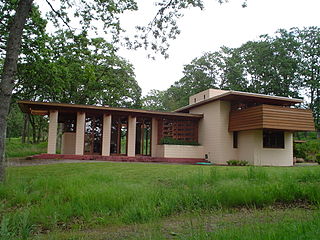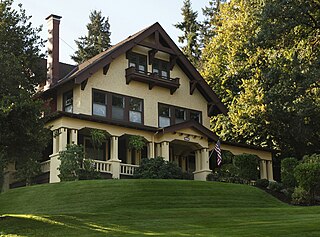
Silverton is a city in Marion County, Oregon, United States. The city is situated along the 45th parallel about 12 miles (19 km) northeast of Salem, in the eastern margins of the broad alluvial plain of the Willamette Valley. The city is named after Silver Creek, which flows through the town from Silver Falls into the Pudding River, and thence into the Willamette River. The community of Milford was founded in 1846 with a sawmill, store and several other buildings two miles upstream from the present location of Silverton. In about 1853 a second sawmill was built on Silver Creek near where the Silverton city hall now stands. In 1854 the town of Silverton was platted and registered with Marion County. Human habitation of the Silverton area extends back approximately 6,000 years before the present. In historical times, the region was dominated by the Kalapuya and Molala peoples, whose seasonal burns of the area made it plow-ready and attractive to early 19th century Euro-American settlers. Farming was Silverton's first major industry, and has been a dominant land-use activity in and around Silverton since the mid-19th century.
Adams House may refer to:

Silver Falls State Park is a state park in the U.S. state of Oregon, located near Silverton, about 20 miles (32 km) east-southeast of Salem. It is the largest state park in Oregon with an area of more than 9,000 acres (36 km2), and it includes more than 24 miles (39 km) of walking trails, 14 miles (23 km) of horse trails, and a 4-mile (6.4 km) bike path. Its 8.7-mile (14.0 km) Canyon Trail/Trail of Ten Falls runs along the banks of Silver Creek and by ten waterfalls, from which the park received its name. Four of the ten falls have an amphitheater-like surrounding that allows the trail to pass behind the flow of the falls. The Silver Falls State Park Concession Building Area and the Silver Creek Youth Camp-Silver Falls State Park are separately listed on the U.S. National Register of Historic Places.

Bobbie the Wonder Dog (1921–1927) was a dog who is acclaimed of walking 2,551 miles (4,105 km) on his own to return home to Silverton, Oregon, United States, after he was lost while his owners were visiting family in Wolcott, Indiana. Ripley's Believe It or Not! estimated the journey may have been as long as 3,000 miles (4,800 km).

The Gordon House is a residence designed by influential architect Frank Lloyd Wright, now located within the Oregon Garden, in Silverton, Oregon. It is an example of Wright's Usonian vision for America. It is one of the last of the Usonian series that Wright designed as affordable housing for American working class consumers, which—in 1939—were considered to have an annual income of $5,000–6,000. The house is based on a design for a modern home commissioned by Life magazine in 1938.
Drake House or Drake House Museum may refer to:

The Drake Park Neighborhood Historic District is located adjacent to Drake Park near the historic downtown area in Bend, Oregon, United States. Because of the unique and varied architecture in the Drake Park neighborhood and its close association with the early development of the city of Bend, the area was listed on the National Register of Historic Places in 2005.

Independence Historic District in Independence, Oregon, United States is a historic district that was listed on the National Register of Historic Places (NRHP) in 1989. The roughly 30-block district preserves approximately 250 homes and businesses of a prosperous riverside town of the 1880s.

The Belle Ainsworth Jenkins Estate, located near Beaverton, Oregon, United States, is listed on the National Register of Historic Places. Built starting in 1912, the main house on the property was intended as a summer home. The entire 68-acre (28 ha) estate is owned by the Tualatin Hills Park & Recreation District (THPRD). The estate has eight buildings, including the main home and a farmhouse built in 1880.

The Murton E. and Lillian DeGuire House is a historic house built in 1906 and located in Silverton in Marion County, Oregon. It was built in the "Free - Classic Queen Anne" style with modest ornamentation that includes leaded glass, projecting bays, groups of windows that include both long and short windows, and differing siding textures. The basic block form with dormers and gables is perhaps most commonly associated with the Colonial Revival Style.

The Louis J. Adams House is a historic house located in Silverton in Marion County, Oregon. It was listed on the National Register of Historic Places in 2011.











